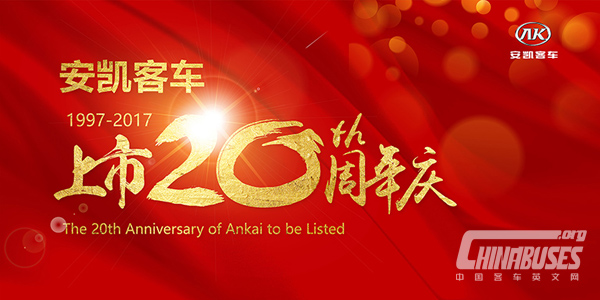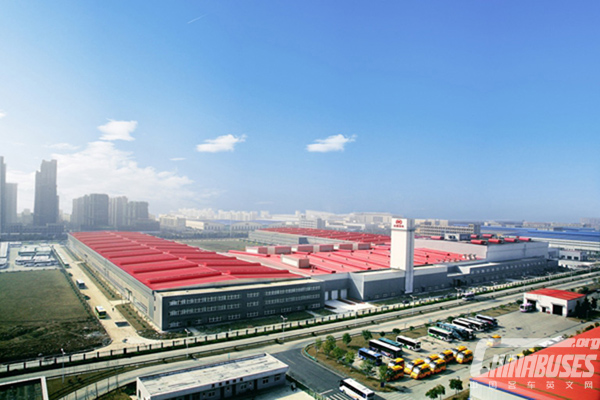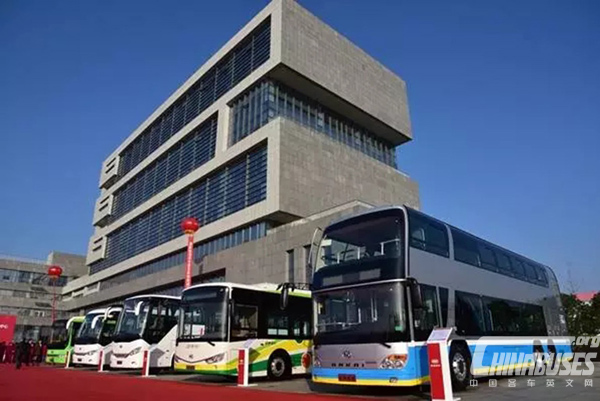On July 25 this year, Ankai held a grand ceremony to celebrate 20th anniversary of its public listing. On the same day twenty years ago, Ankai officially went public at Shenzhen Stock Exchange (stock code: 000868).

With a pioneering spirit, Ankai has been committed to pushing China’s bus manufacturing industry to the main stage of the international market. For the past twenty years, it has been maintaining a fast growing momentum. As of 2016, its market value reached 4.6 billion RMB, 4.75 times larger than that when it was first listed on the market. In the meantime, its total assets ballooned by 13 folds, reaching 9,078,410,000 RMB from 661,030,000 RMB. Its annual sales volume increased 19 times, reaching 10,131 units in 2016 from 517 units in 1997. Its main business revenue jumped by 11 folds, from 420,690,000 RMB in 1997 to 4,757,330,000 RMB in 2016. For seven consecutive years, Ankai had managed to sell over 10,000 units buses. Only a few bus makers in China had made such an impressive performance.

Ankai has witnessed a series of dramatic changes in China’s bus industry in the past twenty years. By constantly improving its corporate management, developing state-of-art technologies, promoting its brands in the international market, and strengthening its presence both at home and abroad, Ankai has made tremendous contributions to the development of China’s bus industry.
In 1993, Ankai started cooperation with Germany-based Benz-Setra, ushering a new era in China’s bus making history. In 1996, Ankai’s new coaches, equipped with S315HD technologies, were put into operation on the passenger transport route between Chengdu and Chongqing.
In 1997, Ankai officially went public on Shenzhen Stock Exchange, thus the bus maker entered the fast-track development age. In 2003, Ankai accomplished restructuring with JAC. After the restructuring, Ankai further improved its business line which focused on developing and producing luxury coaches and also covered city buses, sight-seeing vehicles.
In 2013, under the leadership of its new management team, Ankai initiated a new round of development. By adhering to its philosophy and pursuing high craftsmanship, it has greatly strengthened its overall competitiveness in the global bus market.
In December 2014, when Chinese president Xi Jinping made an inspection tour in Jiangsu province, Ankai Best coach provided transport service. In the same year, the General Armament Department of China’s Liberation Army bought 1,600 units military vehicles from Ankai. On September 3, 2015, Ankai Best coaches appeared at China’s V-day Parade, fully demonstrating its overall strengths and attracting global attention.

Ankai Beautiful China Tour, a brand promotion campaign, has become well known among the public. In addition, it has built China’s first electric city bus route, No.18 Bus Route in Hefei. Ankai e-Control System, the first new energy intelligent management system, has been widely used. Ankai Customer Care, Ankai Bus Safety Initiative has pointed the right way for China’s bus industry.
Having already established a formidable presence in China, Ankai buses have also made their way to over 60 countries and regions around the globe, including U.S.A., the UK, Russia, Dubai and Australia. This year alone, 500 units Ankai gas-fueled city buses were shipped to Myanmar and 600 units Ankai A9 luxury coaches made their way to Saudi Arabia.

Now standing at a new critical moment, Ankai holds fast to its mission and puts innovation, green development and high craftsmanship on the top of its development agenda. It is fully committed to producing higher quality bus products and providing tailored services for its customers.
Currently, Ankai boasts four whole vehicle manufacturing bases and one spare part production base. It is capable of rolling out 20,000 units buses each year. As a state-level hi-tech enterprise, a state-level innovation pilot enterprise and a hi-tech enterprise listed on China’s Torch Plan, Ankai has built a state-level Electrc Bus Whole Vehicle Integration Engineering Center and a state-level Post-doctoral Research Station.